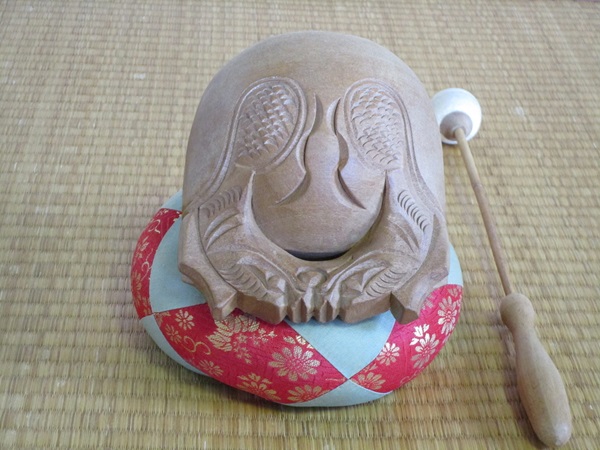



There are over 50 hobby clubs at a nearby municipal welfare facility for the elderly. They each work twice a month for about two hours each time. All of them are lively and are very helpful in increasing the vitality of the elderly. One of those circles is a chorus group that my wife is also a member of.
That was a few months ago. From the next time onwards, she will bring my family mokugyo for the activity. Apparently, the “Shojoji Tnukibayashi" will be featured in the practice song, and it will be used as the instrument. It seems that my family is the only one among the members that has a mokugyo at home. My ancestors might scold me, but I reluctantly allowed them to use it, telling them to take good care of it.
Why isn't it in everyone's house? If you think about it, it may be that many people have it at their parents' house, but not at their own residence. My family also has a history of bringing Buddhist altars with them when we dismantled our parents' home. Come to think of it, even though I brought it with me, I never chanted sutras while beating it. First of all, even if I try to chant it, I don't know the sutra.
That's why I decided to summarize Mokugyo in this section. The wooden fish is one of the Buddhist utensils, and is essentially a musical instrument designed to regulate the rhythm of the sutras. It is said that it came from China in the early Edo period. Wood such as camphor tree is air-dried, shaped into a round shape and hollowed out inside, with slits added to allow the sound to resonate better.
The exterior is engraved with a pattern that resembles fish scales.The scale pattern is said to have the meaning that monks should always be diligent in their training without being lazy, just like a fish that never closes its eyes and sleeps. In the hallways of Zen temples, there is a board called a fishing board in the shape of a fish that is hung to tell the time, and this is said to be the original form. Although mokugyo is a Buddhist utensil, it is used in the Tendai, Jodo, Shingon, and Soto sects, and has no connection with the Jodo Shinshu sect.
When a large group of people pray to the Buddha, if we keep track of the beat, we can certainly read the sutras in unison. Come to think of it, I remember when I was a child, the village youth group organized a band with a mokugyo placed next to the drum, which made the rhythm resonate. It's no wonder that it's also popularly known as the temple block or slit drum.
That soft popping sound makes the listener feel lighter. Certainly, it is a waste to just use it for Buddhist utensils. Of course, you have to be very careful not to disrespect your ancestors, but it is a perfect percussion instrument for musical activities. I'm sure even our ancestors would be rather impressed by the sight of the elderly people who will be arriving soon, singing “sho!sho!shoshoji!”.
(October 7, 2023 Yoshihiro Fujiwara)